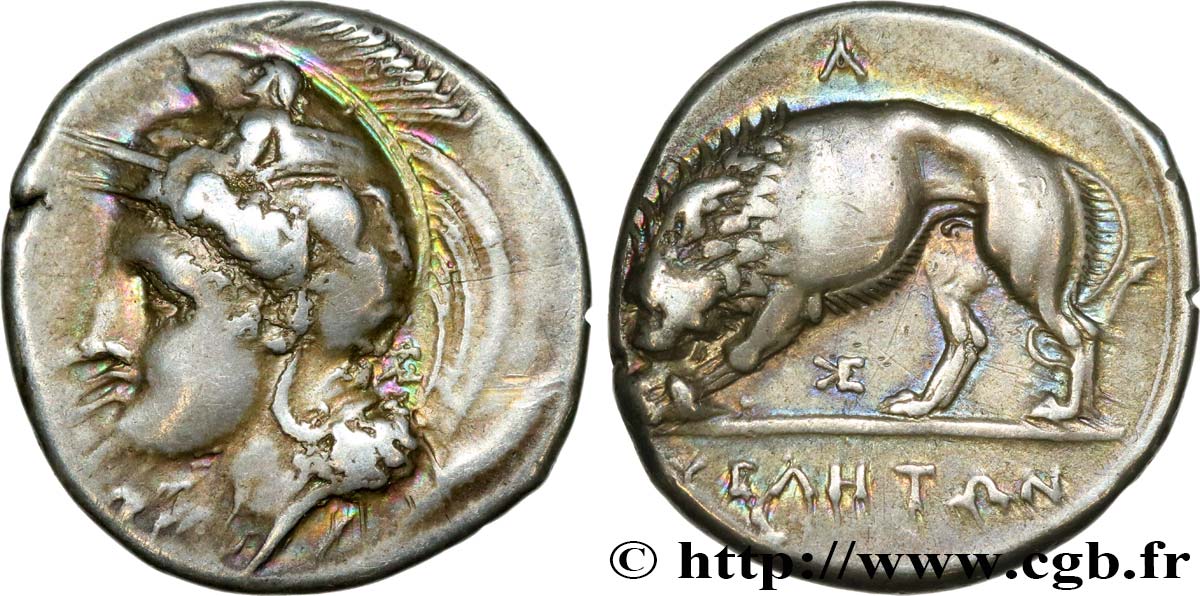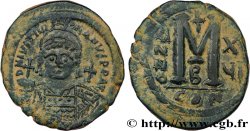bgr_534320 - LUKANIEN - VELIA Nomos, statère ou didrachme
Nicht verfügbar.
Artikel auf unserem Online-Shop verkauft (2020)
Preis : 350.00 €
Artikel auf unserem Online-Shop verkauft (2020)
Preis : 350.00 €
Type : Nomos, statère ou didrachme
Datum: c. 350/340 - 320/310 AC.
Name der Münzstätte / Stadt : Vélia, Lucanie
Metall : Silber
Durchmesser : 20 mm
Stempelstellung : 6 h.
Gewicht : 7,49 g.
Seltenheitsgrad : R1
Kommentare zum Erhaltungszustand:
Exemplaire sur un flan ovale bien centré des deux côtés. Belle tête d’Athéna. Joli revers. Belle patine de médaillier avec des reflets dorés irisés bleutés
N° im Nachschlagewerk :
Vorderseite
Titulatur der Vorderseite ANÉPIGRAPHE ; MONOGRAMME DERRIÈRE LE CASQUE.
Beschreibung Vorderseite Tête d'Athéna à gauche, coiffée du casque phrygien à cimier avec triple aigrette, orné d'un centaure.
Legende des Averses (KE)
Rückseite
Beschreibung Rückseite Lion passant à gauche, dévorant une proie.
Legende des Reverses : ULHTWN/ A/ (KE)
Kommentare
De mêmes coins que les exemplaires de l’Ashmolean Museum d’Oxford (SNG Oxford, 1279 à 1281). La série 60 du classement de Williams se caractérise par un monogramme qui correspond à la signature du graveur Kléodoros. Sur cet exemplaire, on distingue très nettement un début de cassure de coin au droit devant le visage. Au revers, on remarque la présence de deux minuscules points devant l’antérieur et sous la queue. Très tôt, le monnayage de Vélia a été décrit comme ayant inspiré la drachme lourde de Marseille (LT. 785-791). Certains l’ont même décrit comme un monnayage symmachique : un lion de Vélia étant l’équivalent de deux lions de Marseille. Aujourd’hui, cette théorie est remise en cause.
Same dies as the examples in the Ashmolean Museum in Oxford (SNG Oxford, 1279 to 1281). Series 60 of the Williams classification is characterized by a monogram that corresponds to the signature of the engraver Kleodoros. On this example, we can clearly see the beginnings of a die break on the obverse in front of the face. On the reverse, we note the presence of two tiny dots in front of the fore-end and under the tail. Very early on, the coinage of Velia was described as having inspired the heavy drachma of Marseille (LT. 785-791). Some have even described it as a symmachic coinage: one lion of Velia being the equivalent of two lions of Marseille. Today, this theory is being challenged
Same dies as the examples in the Ashmolean Museum in Oxford (SNG Oxford, 1279 to 1281). Series 60 of the Williams classification is characterized by a monogram that corresponds to the signature of the engraver Kleodoros. On this example, we can clearly see the beginnings of a die break on the obverse in front of the face. On the reverse, we note the presence of two tiny dots in front of the fore-end and under the tail. Very early on, the coinage of Velia was described as having inspired the heavy drachma of Marseille (LT. 785-791). Some have even described it as a symmachic coinage: one lion of Velia being the equivalent of two lions of Marseille. Today, this theory is being challenged








 Berichten über einen Fehler
Berichten über einen Fehler Die Seite drucken
Die Seite drucken Teilen meiner Auswahl
Teilen meiner Auswahl Stellen Sie eine Frage
Stellen Sie eine Frage Einlieferung/Verkauf
Einlieferung/Verkauf
 Details
Details















